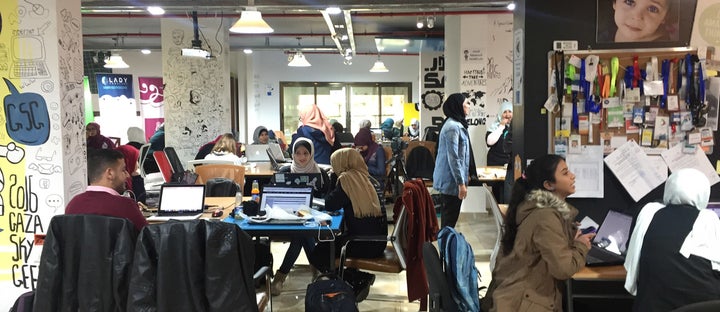A typical hackathon* has 20 percent female participants. This month in Gaza, AngelHack held one of their 20 global Lady Problems Hackathons at the Gaza Sky Geeks (GSG) accelerator, the first and only accelerator in Gaza. Eighty-three percent of the participants were female — AngelHack’s highest female participation to date (and possibly of any hackathon, ever).

There was a lot to be impressed and inspired by during my short visit to GSG, but certainly their ability to attract so many female coders stood out as a strong example of the immediate opportunity to improve diversity in tech, despite economic, social, and cultural barriers. Here are some of the strategies they used to achieve this:
1. Make Women a Priority
If you want more women in your firm, accelerator, or hackathon, you need to make it a priority and embed this priority into all levels of the organisation. Gaza Sky Geeks, for example, has women on their board, a female co-founder, and female advisors, staff, mentors and volunteers. They’ve also created a specific role, Women’s Inclusivity Programs Fellow, to manage the programs, events, and workshops for women, including coding clubs, hackathons and proposals for fostering more female founders.
2. Set Targets
When trying to achieve anything, setting targets and goals and taking measurement can be very helpful. In step one, we set gender diversity as an organisational priority — now we need to quantify that in order to track and be accountable for those priorities. When GSG started getting 30 percent female representation at their events, they could have stopped there: on average globally, the tech workforce is 30 percent female. Instead, they chose to continue to push themselves to achieve a target of 50 percent women, representative of the general population and an equality that helps reduce the influence of other forms of bias.
3. Engage women early, using the channels relevant for them
In order to achieve greater female participation at events, they began actively recruiting for women early on, and gearing engagement activities towards them. Women are often juggling numerous responsibilities, such as childcare, and being able to plan in advance can greatly increase their ability to attend. Using the channels relevant for them will not only help them to become aware of the event, but will reinforce the fact that they should be taking part. Prior to the Lady Problems Hackathon, Rana Alqrenawi, GSG’s Women’s Inclusivity Programs Fellow, conducted outreach at local universities, held informational events as early as two months before the hackathon, and created a Facebook Group to keep potential female participants in the loop.
4. Uncover the barriers and solve for them
Do your research to understand what are the most significant barriers for women in your context and test strategies to help overcome them.
One potential barrier many young women in Gaza reported was confidence and self-esteem. Understanding this as a reality, Gaza Sky Geeks engages with local schools and universities, meeting with female students to teach them about the center and events. Alqrenawi held intensive trainings and workshops ahead of the hackathon to teach women about prototyping, discuss their ideas and the event criteria, and help them to hone their coding and design skills, in order to get to a level where they felt comfortable to participate. It was wonderful to hear their stories first-hand about how learning to code was helping them to feel more confident in all areas of their lives.
Another potential barrier for women is their responsibilities at home. Engagement with families was important to help them understand the nature of the program and the necessary commitment, as most young Gazans still live at home. Cost of transportation to the accelerator was covered by GSG initially, in order to further convince families to allow their daughters to go. As women began participating, shared their stories from the space and the skills they were learning, families became increasingly supportive, particularly as their recognized their daughters own potential to generate income.
5. Provide role models
Young women need to have role models which they can relate to. Their role models won’t all be women, but it helps to have both there for them to look up to. Having women CEOs and Founders in the GSG accelerator is a great help to recruiting more females in the space — they get inspiration from seeing other female entrepreneurs who are walking the walk and a demonstration that women can achieve success in tech as well. It was clear from my time there that the female staff and mentors (as well as the positive male role models who fully and openly supported their work) provided a strong source of inspiration and guidance for the female participants.
6. Involve men
Ultimately, our goal is egalitarianism: equal and open representation of women in tech. To achieve this, engaging the other half of the population, boys and men, is key. From the leadership team to the staff, mentors, and hackathon participants at Gaza Sky Geeks, the males in the room were genuinely supportive, collaborative and proud to have many female colleagues building great things with them.
Having more women participants in the Hackathon and in the accelerator overall increases the social balance, brings new perspectives and, commercially, helps startups to avoid missing out on 50 percent of the market.
This isn’t a matter of CSR or PR and it even goes beyond values: diverse teams are proven to be more successful. Any extra efforts will soon pay off as you as you uncover new talent pools and reap the benefits of an inclusive entrepreneur community.
To learn more about the GSG, make a donation, or become a mentor, visit gazaskygeeks.com.
